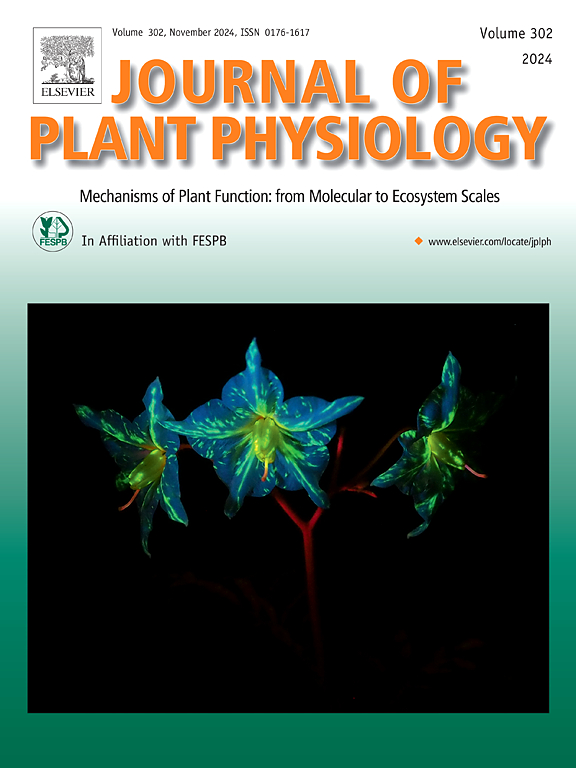Systematical accumulating and regulating evaluations of leaf functional metabolites in geographically isolated edible medicinal plants of Piper sarmentosum
IF 4.1
3区 生物学
Q1 PLANT SCIENCES
引用次数: 0
Abstract
The edible medicinal plant Piper sarmentosum is widely distributed in south China. This study raised a hypothesis of geographically isolated P. sarmentosum plants possessing potential site- or/and plant-dependent accumulating metabolites, expressing genes, and colonizing bacteria. Here, P. sarmentosum plants of Guangzhou City (PG, comparison group) and Hainan Island (PH, control group) were collected for assaying leaf metabolomes (LMs), leaf transcriptomes (LTs), and leaf-assembled bacterial communities (LABCs), respectively. In LMs and LTs, 930 metabolites and 82,606 unigenes were identified with 552 differently accumulated metabolites (DAMs) and 28,177 differently expressed genes (DEGs), respectively. In LABCs, cluster analysis yielded 822 PG-PH-common, 1114 PG-unique, and 203 PH-unique operational taxonomic units (OTUs). In contrast of PH-LMs, the elevated accumulations of alkaloids and lipids and the decreased accumulations of flavonoids and phenolic acids were observed in PG-LMs. Typically, the DAMs and DEGs were co-enriched in two metabolic pathways of phenylpropanoids and flavonoids, visibly displaying the related DEGs, such as chalcone synthase (CHS), chalcone isomerase (CHI) and phenylalanine amino lyase (PAL), with regulating the functional DAMs, such as phenylalanine, tyrosine, p-coumaric acid, and naringenin. Noticeably, these DAMs were also significantly correlated with a number of different types or/and abundances of leaf-assembled bacteria (DTAB) between PG- and PH-LABCs, such as Flavobacterium and Pseudomonas. Therefore, this study clearly elucidated the functional metabolite accumulations and the close relationships with plant mRNA expressions and bacterial colonizations in geographically isolated plants of P. sarmentosum, providing new insight of selectively utilizing leaf food- and medicine-associated metabolites in different habitats of edible medicinal plants.

地理分离药用辣椒叶功能代谢物的系统积累与调控评价
可食药用植物沙薄荷广泛分布于中国南方。本研究提出了一种假设,即地理上分离的沙薄荷植物具有潜在的位点或/和植物依赖性积累代谢物,表达基因和定殖细菌。本研究收集广州市(PG,对照组)和海南岛(PH,对照组)的沙门草叶代谢组(LMs)、叶转录组(LTs)和叶组装细菌群落(LABCs)进行分析。在LMs和LTs中,分别鉴定出930种代谢物和82,606种单基因,分别含有552种不同累积代谢物(DAMs)和28,177种不同表达基因(DEGs)。聚类分析得到822个PG-PH-common、1114个PG-unique和203个PH-unique操作分类单元(otu)。与PH-LMs相比,PG-LMs生物碱和脂质的积累增加,黄酮类和酚酸的积累减少。典型的是,dam和DEGs共同富集于苯丙素和黄酮类物质的两条代谢途径中,可见查尔酮合成酶(CHS)、查尔酮异构酶(CHI)和苯丙氨酸解氨基酶(PAL)等相关DEGs,并调节苯丙氨酸、酪氨酸、对香豆酸和柚皮素等功能dam。值得注意的是,这些dam还与PG-和ph - labc之间的许多不同类型或/和丰度的叶片组装细菌(DTAB)显著相关,如黄杆菌和假单胞菌。因此,本研究明确了沙门草地理分离植物中功能代谢物的积累及其与植物mRNA表达和细菌定植的密切关系,为可食药用植物在不同生境中选择性利用叶片食药相关代谢物提供了新的思路。
本文章由计算机程序翻译,如有差异,请以英文原文为准。
求助全文
约1分钟内获得全文
求助全文
来源期刊

Journal of plant physiology
生物-植物科学
CiteScore
7.20
自引率
4.70%
发文量
196
审稿时长
32 days
期刊介绍:
The Journal of Plant Physiology is a broad-spectrum journal that welcomes high-quality submissions in all major areas of plant physiology, including plant biochemistry, functional biotechnology, computational and synthetic plant biology, growth and development, photosynthesis and respiration, transport and translocation, plant-microbe interactions, biotic and abiotic stress. Studies are welcome at all levels of integration ranging from molecules and cells to organisms and their environments and are expected to use state-of-the-art methodologies. Pure gene expression studies are not within the focus of our journal. To be considered for publication, papers must significantly contribute to the mechanistic understanding of physiological processes, and not be merely descriptive, or confirmatory of previous results. We encourage the submission of papers that explore the physiology of non-model as well as accepted model species and those that bridge basic and applied research. For instance, studies on agricultural plants that show new physiological mechanisms to improve agricultural efficiency are welcome. Studies performed under uncontrolled situations (e.g. field conditions) not providing mechanistic insight will not be considered for publication.
The Journal of Plant Physiology publishes several types of articles: Original Research Articles, Reviews, Perspectives Articles, and Short Communications. Reviews and Perspectives will be solicited by the Editors; unsolicited reviews are also welcome but only from authors with a strong track record in the field of the review. Original research papers comprise the majority of published contributions.
 求助内容:
求助内容: 应助结果提醒方式:
应助结果提醒方式:


